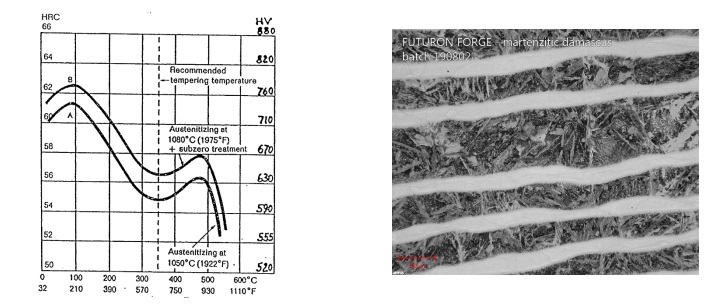Technical Information – AEB-L Core
Composition
FF AEB-L Core is a san-mai layered stainless damascus composed of an Uddeholm AEB-L core and AEB-L + AISI 304 steels placed on the sides. AEB-L is martensitic stainless steel with a fine structure developed for razors and surgical scalpel production. This steel is hardenable up to 64 HRc; however, we recommend reaching 60-61 HRc hardness for knife blades.

Machining conditions
Our products are soft annealed to provide the best possible machining, reaching hardness approx. 280HV. You can use all conventional types of machining. We don’t recommend cutting (format) material on machine shears. We recommend bandsaw cutting, milling or laser, or waterjet cutting. We recommend setting the knife edge’s position outside of damascus flat. The thickness of the core slightly expands from the center to the edges.
- Milling – monolithic carbide mill — Vc50-60 m/min
- For hard-milling (sizing) with monolithic carbide, mill feed up to Vc100 m/min
- Milling with VBD mill — Vc75-100 m/min
- Milling with HSS-Co mill — Vc14-16 m/min
- Drilling – HSS-Co drill — Vc10-12 m/min
- Drilling – PVD coated carbide drill —Vc60-80 m/min.

Grinding
You can grid our steel on all conventional types of grinders. We recommend belt-grinders or Berger grinding machines. For belt grinders, we recommend sanding belts with ceramic grains, like 3M Cubitron II; however, all range of conventional abrasives is usable (for example, SAIT, Klingspor, Norton, VSM, etc.). Watch out for not to overheat (tempering) the steel by grinding. When it’s heat-treated, it may lose the required properties.
Soft annealing
- Our materials are delivered soft annealed. You have to apply this process only after forging.
- Heat the material in a furnace to 820 °C / 1508°F
- Hold at the temperature for 4 hours at least
- Slow cooling in a furnace
- You can remove the steel from a furnace when the temperature drops below 380°C / 716°F.
Hardening
Hardening is necessary to reach full corrosion resistance and the final hardness of the steel. We recommend hardening the steel by heat treatment professionals using vacuum technology like Bodycote. Recommended hardening process:
- Preheating temperature 1050-1080 °C / 1922-1976°F.
- Hold at the temperature for 15 minutes
- Cooling by nitrogen gas (oil-bath is also possible)
- Immediate deep freeze.
Tempering
After hardening, it’s necessary to begin the tempering process as soon as possible.
- We recommend tempering process 2x1h 150-180 °C / 302-356°F (60-61 HRc) for knife blades
- Repeat deep freeze, after the first hour of the tempering process.

Etching
To properly contrast the damascus steel layers, it’s necessary to etch the material (blade). You can experiment with various etching techniques depending on your skill; however, following the below-mentioned steps, you’ll get nice results.
- Ensure that the blade’s surface is smooth, clean, and free of scratches (since etching won’t hide them), finished up to 1000+ grit or polished.
- Properly degrease the blade; cleaning it in the soap-water works well.
- Before etching, we recommend testing the solution on a sample piece of heat-treated material.
- You can reuse the etching solution several times. Before you get the blade into the solution, check if there’s no dirt on the solution’s surface.
- When the etching is finished, you have to neutralize the blade using Na₂CO₃ (Sodium carbonate) or NaHCO₃ (Baking soda). You can also use soap and water and properly clean the etching residues from a blade.
- Dry the etched blade. We recommend spraying the blade with WD-40 (or similar) and drying it again to remove any possible residues.
- You can slightly polish the etched blade on a buffing wheel for better contrast. We recommend testing it on a sample piece.
- If you want to make your etching solution more reactive, increase the concentration of Fe3Cl or add vinegar.

Marking
FF AEBL Core
@futuronforge #HardCOREfuturon
Adresa
Futuron Forge s.r.o.
EU – Czech Republic
Tržiště 372/1
118 00 Praha
IČ: 08244189
DIČ: CZ08244189
Sledujte nás
[instagram-feed]